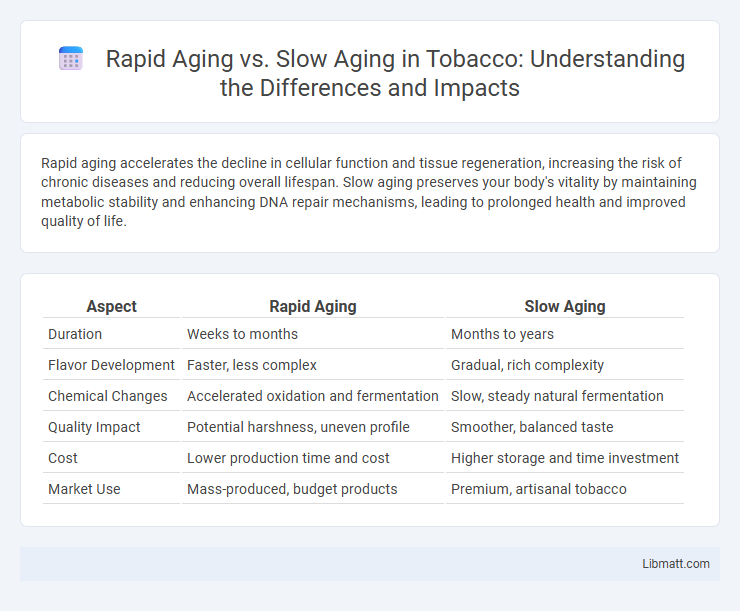Rapid aging accelerates the decline in cellular function and tissue regeneration, increasing the risk of chronic diseases and reducing overall lifespan. Slow aging preserves your body's vitality by maintaining metabolic stability and enhancing DNA repair mechanisms, leading to prolonged health and improved quality of life.
Table of Comparison
| Aspect | Rapid Aging | Slow Aging |
|---|---|---|
| Duration | Weeks to months | Months to years |
| Flavor Development | Faster, less complex | Gradual, rich complexity |
| Chemical Changes | Accelerated oxidation and fermentation | Slow, steady natural fermentation |
| Quality Impact | Potential harshness, uneven profile | Smoother, balanced taste |
| Cost | Lower production time and cost | Higher storage and time investment |
| Market Use | Mass-produced, budget products | Premium, artisanal tobacco |
Understanding the Science of Aging
Rapid aging accelerates cellular damage through oxidative stress and genetic factors, leading to earlier onset of age-related diseases. Slow aging involves enhanced DNA repair mechanisms and efficient metabolic processes that preserve tissue function and delay senescence. Understanding the science of aging empowers you to adopt lifestyle choices that support longevity and healthy aging.
Key Differences Between Rapid and Slow Aging
Rapid aging is characterized by accelerated cellular degradation, increased oxidative stress, and a higher incidence of age-related diseases, whereas slow aging involves enhanced cellular repair mechanisms, reduced oxidative damage, and prolonged physiological function. Key differences include telomere shortening rate, mitochondrial efficiency, and levels of chronic inflammation, all of which influence lifespan and healthspan outcomes. Genetic factors, lifestyle choices, and environmental exposures play critical roles in determining whether an individual experiences rapid or slow aging processes.
Genetic Influences on Aging Rates
Genetic influences on aging rates play a critical role in determining whether rapid aging or slow aging occurs, with specific gene variants like APOE and FOXO3 linked to longevity and age-related diseases. Researchers identify that telomere length, largely inherited, affects cellular aging speed, with shorter telomeres accelerating the aging process. Your genetic makeup sets a baseline for aging, but lifestyle factors can modulate these genetic effects to influence overall healthspan.
Environmental Factors Affecting Aging Speed
Exposure to air pollution, UV radiation, and chronic stress accelerates rapid aging by damaging skin cells and disrupting cellular repair mechanisms. Conversely, slow aging is associated with environments rich in antioxidants, clean air, and low stress levels that promote cellular health and DNA integrity. Lifestyle factors such as diet, sleep quality, and regular physical activity also play crucial roles in modulating the rate of aging.
Lifestyle Habits: Accelerators vs. Decelerators
Lifestyle habits significantly influence the rate of aging, with accelerators including smoking, excessive alcohol consumption, poor diet, and chronic stress, which increase oxidative damage and inflammation. In contrast, decelerators such as regular physical activity, balanced nutrition rich in antioxidants, adequate sleep, and effective stress management promote cellular repair and longevity. Scientific studies highlight the role of caloric restriction and Mediterranean diet patterns in slowing biological aging by enhancing mitochondrial function and reducing age-related diseases.
The Role of Diet and Nutrition in Aging
Diet and nutrition significantly influence the rate of aging by impacting cellular health, inflammation, and oxidative stress. Nutrient-rich foods high in antioxidants, vitamins, and healthy fats promote slow aging by protecting DNA and supporting metabolic functions. Your dietary choices can either accelerate aging through processed foods and sugar or help maintain vitality with balanced, whole-food nutrition.
Exercise and Physical Activity: Impact on Aging
Regular exercise and physical activity significantly influence the rate of aging by enhancing cardiovascular health, maintaining muscle mass, and improving cognitive function. Sedentary lifestyles accelerate biological aging through increased inflammation and decreased metabolic efficiency, whereas consistent physical activity promotes cellular regeneration and reduces oxidative stress. Incorporating exercise into Your daily routine can slow aging processes, resulting in improved longevity and quality of life.
Common Signs of Rapid vs. Slow Aging
Common signs of rapid aging include deep wrinkles, significant loss of skin elasticity, and early appearance of age spots, while slow aging typically features fewer wrinkles, smoother skin tone, and minimal discoloration. Rapid aging often involves decreased muscle mass and weakened bone density at an accelerated rate, compared to slow aging where these changes occur gradually and less noticeably. Your lifestyle and genetics play crucial roles in determining whether you display characteristics of rapid or slow aging.
Preventive Strategies for Slowing Down Aging
Preventive strategies for slowing down aging focus on maintaining cellular health through antioxidants, balanced nutrition rich in vitamins and minerals, and regular physical exercise to enhance cardiovascular and metabolic function. You can implement stress reduction techniques like meditation and adequate sleep to reduce inflammation and promote hormonal balance, which are critical for longevity. Incorporating these habits supports DNA repair mechanisms and limits oxidative damage, thereby slowing the biological aging process.
Innovations and Research in Anti-Aging Technologies
Innovations in anti-aging technologies have accelerated breakthroughs in understanding cellular senescence, DNA repair, and metabolic regulation, enabling targeted therapies to slow aging processes. Cutting-edge research explores senolytics, gene editing, and NAD+ boosters to combat rapid aging and extend healthspan effectively. Your access to personalized anti-aging treatments is expanding as precision medicine harnesses these advances to customize interventions for optimal longevity.
Rapid aging vs slow aging Infographic

 libmatt.com
libmatt.com